
On May 14, 1992, the largest and most complete Tyrannosaurus rex fossil ever found(named "Sue" after discoverer Susan Hendrickson) was seized from the Black Hills Institute of Geological Research(BHIGR) in Hill City, South Dakota. At the behest of acting U.S. Attorney Kevin Schieffer, 9 FBI agents, 4 National Park rangers, 2 agents from the Department of Interiors office of Inspector General, 1 Bureau of Indian Affairs agent, 1 South Dakota Highway Patrolman, 1 Pennington County Deputy Sheriff, and several paleontologists or other scientists, executed a search and seizure warrant, which had been signed the previous afternoon by U.S. District Court Judge Richard Battey of Rapid City. The National Guard was also dispatched to join in the raid.

Sue is loaded onto trucks and convoyed down to the School of Mines and Tech. in Rapid City.
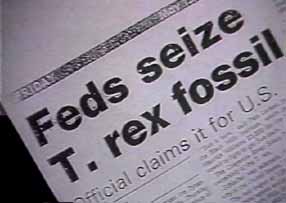
The Seizure of Sue made the headlines and sparked public outrage. The acting U.S. Attorney Kevin Shieffer claimed Sue for the federal government, citing the Antiquities Act(1906) for justification. Officials at the Dept. of the Interior later determined that this premise was not valid grounds for the seizure. Schieffer was never confirmed as a U.S. Attorney, had only been on the job as acting U.S. Attorney for a short while, and had never even tried a case before.
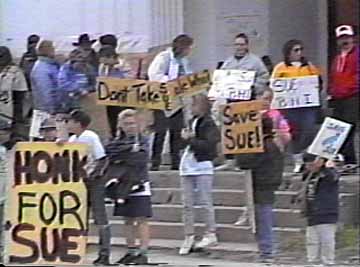
Hill City residents protest the seizure. Local restaurant owners and merchants refused to serve the federal authorities. Loggers contemplated blockading roads with trucks, but cooler heads prevailed.
Eventually, after countless rounds of legal wrangling, posession of Sue was awarded to the landowner where Sue was found. The landowner is a member of the Cheyenne River Sioux Tribe and had placed the land where Sue was found into trust status with the government. Under trust status, the landowner: 1) is free from property tax burden, 2) may not sell the property without the permission of the BIA/Dept. of the Interior. However, severable assets such as oil and minerals may be freely sold by the landowner without federal approval(in contrast to real estate). The landowner was paid $5,000 for the fossil. At that time this was(and might still be)a record payment to a landowner for a specimen still in the ground. He said he was glad they were going to mount Sue in Hill City.
Judge Battey voided the sale of Sue a few years later with a
real gem of contorted legal logic:
He ruled that Sue was "real property" (or real estate)
and that the landowner needed federal government permission to
sell any real estate in trust status. In other words, because
some government form had not been filled out, the apparently
legal and voluntary sale of Sue between the landowner and the
BHIGR was not a valid transaction. If the transaction occurred a
few weeks later, when Sue was out of the ground, it presumably
would have been OK. The U.S. Supreme Court decided not to hear
the case, allowing Battey's unprecedented and highly
controversial legal ruling to stand. As of early 1996, the
landowner says Sue is for sale. The government now says that
their role in this matter is to maximize the profit for the
landowner, with no scientific interest whatsoever.
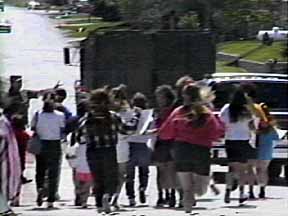
The BHI had enlisted some 30 noted scientists worldwide to work on a common monograph about this spectacular find. Sue was open to the public, being intensively studied by scientists, and her skull was scheduled to be CAT-scanned at NASA for an upcoming piece in National Geographic. It appeared to be a case of public-private scientific cooperation of the finest order until that fateful day in 1992.Why the heavy-handed tactics? What was the justification? Who authorized the the National Guard to participate in an action against American civilians?
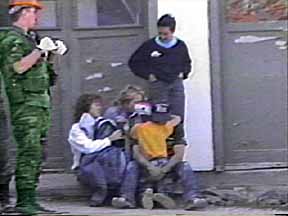
Distraught and stunned BHI personnel comfort each other as most of their career work, spanning decades of fossil collection and preparation were carted up and taken away. Fossil specimens, field notes, photographs and business records were all confiscated. The BHI was subjected to at least 2 episodes of search and seizure without any charges having been filed. When charges were eventually brought many months later, none of them even pertained to Sue.
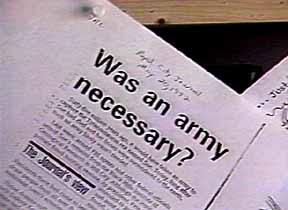
If you or I were a federal prosecutor and someone had alleged to one of us that a respected business had committed a minor misdemeanor (or a minor felony, for that matter) in which neither property nor another human had been injured, would you send an army, and spend a million dollars of taxpayer money, in a SWAT-style attack on that business?
The following 3 articles were written by Bob Newland, a resident of Rapid City who has researched and written extensively on this matter. These articles originally appeared in The Missouri Basin Rider and the Buffalo Chip Gazette.
Copyright 1999 by Pan Terra Inc., PO Box 556, Hill City, SD, USA 57745.
All rights reserved.......Tel or fax 605-574-4760